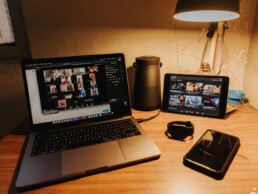Ideas to Improve Virtual Attendee Engagement
Now more than ever, it is vital to understand how to make virtual events more appealing to stakeholders, sponsors, and attendees. A recent poll from a Virtual Planner Master Class showed that 60% of planners are considering shifting their events to virtual or hybrid. With so many businesses temporarily closing or shifting to a remote workforce, there is a demand for fresh ideas that can take ordinary online events to interactive digital experiences for your attendees. Here are some ideas that can paint your virtual event red against a white background.
Don?t Lose Sight of the Physical Aspect
Tangibility is not the first thing that comes to mind when you hear the word ?virtual? ? even more reason to utilize it. If you can manage to pull in a physical aspect, you will set your event apart from the rest.
Looking at a screen can be extremely 2 dimensional. To bring in that 3D element, you?ll have to get creative. If you are a baker, you may consider delivering a cookie kit to those who register for your cookie making tutorial event. That way, your consumers can physically follow along. Or, if you?re a librarian, you may consider delivering a physical copy of a book to your event goers, so your consumers can hold the book.?
There may not be many cookie-bakers and librarians reading this, but the same rule applies for your business?s virtual event. Give a tangible taste of your product or message. This creates value for consumers and adds an interactive element to your next virtual experience.??
Master Class tip: At the last virtual event we hosted, we delivered a tin of Garrett?s Popcorn to each panelist, which offered a positive incentive to the panelists while on the Zoom webinar.
Include Positive Incentives
Think about when you were in high school, around homecoming (I know, bear with me). You may have had spirit days, where you all wore hats to school or fashioned a crazy hairdo. It is likely that this made you more excited to come to school. Well, the same rule applies to virtual events.
Adding a twist to your event, like a virtual happy hour, gives people something to be more excited about. Therefore, people are more likely to express excitement for your event ? just like high school spirit week made you excited to come to school.
It would look something like this: you put together your event, you inform consumers that by attending your event, they will have both the event content and the positive incentive of your choice to look forward to. All of the people who tend to flake may say, ?hmmm? I don?t know if I?m up for it, but a virtual happy hour afterward is pretty cool ? can?t miss that. Alright, I?m in!?
Master Class tip: In order to encourage people in the industry to stay connected at this time, we?ve been offering an optional virtual happy hour at the end of each online event. We normally host monthly networking events and meet-ups, so it makes sense for us to continue to connect people virtually even during this time.?
Broadcasting a Virtual Experience?
Virtual experiences, like cooking demonstrations, comedy lessons, and cocktail demonstrations are all great tools to get your audience interested in attending your virtual event.?
Similar to positive incentives, virtual experiences add excitement and value to the event. With something like a virtual happy hour, the incentive is simply having fun. However, adding a virtual experience or lesson entices people by giving them the opportunity to learn something.?
You can market your virtual event by letting prospective attendees know that they will have knowledge of something new to take away afterward.?
Master Class tip: Master Class Tip: At our Virtual Planner Master Class, we partnered with Live Art International to create a unique virtual experience with DIY Wine Glass Painting Kits. Two days before the event, early registrants received a wine glass in the mail to self-decorate, along with painting materials and an instruction guide. Then, we encouraged everyone to bring their glass to our virtual happy hour. To take things to another level, we gathered selfies of everyone with their wine glasses and put them into a collage to be shared on social media.?
Use Small Group Interaction as a Deliverable
What sets an event apart from a lecture? The answer is simple: interaction. It is important to include small-group opportunities in your virtual event for consumers to see value in it. Speaking to other like-minded individuals makes consumers feel that they are a part of something, and that ?something? is your brand.
For optimal engagement, it is important to preload poll questions to captivate your audience and gather feedback. If you are looking to gather any poll feedback, you should launch the poll with at least 5 minutes of programming left.
Small groups will give your event the value of socialization, brainstorming, discussing, and more. This value is the perfect deliverable to market to consumers. Utilizing Zoom breakout rooms shifts the event from passive to active. Make it known that your event is different because it is not just a lecture, but a collaborative colloquy.
Master Class tip: To encourage small group interaction at our virtual events, we break the group into multiple smaller groups. We shuffle people around intermittently to offer maximum networking opportunities. Our timing formula changes based on the content and audience of the event, but we found moving people around keeps them engaged for much longer than a presentation format does.
Author: Emma McVady, Ateema
5 Trends To Think About While Pivoting Back to Live Events
As companies try to resume conducting business under the new normal, it will be a learning curve for all including event planners, hosts, vendors, venues, and attendees. Adjusting to the new norm post-COVID-19, those that are able to be flexible, adaptable and can pivot during these challenging times could be the most successful!  Keeping an open mind to new ways of hosting events which includes human interaction can be very advantageous as the industry plans for live events. Here’s our projections for what trends we might see when we start meeting in person again...
Never Enough Precaution
Besides checking your typical details with vendors, suppliers, and the venue, safety and security processes will now be incorporated. These safety protocols should be communicated to your guests to ensure them that their health and safety are at the forefront. It is now standard protocol to have a COVID-19 event checklist that includes temperature checking of employees and guests, in addition to requiring all to wear a face covering. There will be a dramatic difference with how everyone interfaces with each other as well. Long gone are the days where greeters are handing out materials such as maps and agendas as events will establish more self-service features for their participants. In addition, hand sanitizer will be more readily available and very much appreciated. Guests might be limited to bringing their belongings as ensuring the safety for both your guests and employees will go a long way. 
Innovative Food Options
It is important that participants feel all safety precautions were considered when it comes to the food being served at the events. As part of taking precautionary measures, buffets may not be a popular option to avoid serving utensils having multiple touches and to avoid people standing in lines. But don’t worry, planners are looking at creative meal options. Boxed lunches or pre-packed grab and go individual meals will be offered as well as seated meals. Planners will also be thinking outside of the box such as leveraging favorite food trucks or catering from your popular restaurants with carry out style options to still make it an enjoyable event. Although seating may be more restricted in numbers at a table, who says you can’t have a great experience with a smaller intimate group which may encourage better networking and connections?
Behind-the-Scenes Workers Now in the Spotlight
Pre-COVID 19, it was all about seamlessly transitioning the events with flipping the rooms quickly to avoid any type of event distractions. Post COVID-19 attendees might want the staff to be more visible. Seeing them frequently wiping down high touched spaces and continuous cleaning will now be more than welcomed. As well, I’m sure attendees won’t mind the cleaning crew to spend a little extra time in between room flips.
Empty Rooms a Good Thing Now?
In order for participants to feel comfortable to be in the same room with others while allowing the appropriate social distance, it is now acceptable and expected that rooms are not filled to capacity to reassure their guests. Brainstorming possible event room layouts with bigger rooms for less people and to how to space out the furniture will be key. Foot traffic directions that include warning signs that show “high traffic†or “high touch areas†will be part of the event set up too. Lastly, event planners will need to consider the staff’s ability to wipe down as frequently as possible based on venue layout.
Hybrid! Hybrid! Hybrid!
As we adjust to our new norm, hybrid events should be considered as an option. Hybrid events combine live people with virtual attendees and with budgets that may be more limited to hosting smaller groups this still allows for that personal connection. Something else to consider is combining live presentations and entertainment broadcasted from different rooms as that will help avoid having too many people in one room at a time. An additional benefit to hosting hybrid events, is the ability to be more flexible because the resources that you will be depending on will be more limited such as security, staff, catering, PPE, cleaning supplies, etc. Hybrid is a great alternative option for those who may still fear gathering with other people but also an opportunity to keep your event participation rate high.
How to Craft Your New Site Visit Checklist Post COVID-19
Cleanliness 
As businesses slowly begin to reopen, it will be important as you plan your events to consider the health and safety of the guests. At this point, there should be more evident measures that the venue has or is doing to ensure the health or safety of both their staff and guests. As you complete your site visits, evaluating the protocols they have put in place such as cleanliness of the bathroom should be considered. Ask them, how often will the bathrooms be cleaned and disinfected during your event? In addition, you should evaluate the safety protocols for their staffers, will they be wearing masks now as they pass around appetizers and interface with the guests? What are they doing to take precautions with food preparation  and have serving methods changed, we already know buffets are a thing of the past - will individual food containers be a thing of the future?
Social Distancing
Will events be limited to 25% capacity, 50%, or are we concerned at all? Other things to consider is venue space and options to accommodate social distancing requirements. Does the venue have outdoor space to use, how tall are the ceilings in the room(s), how updated is the ventilation system and air filters, can we use multiple rooms to allow social distancing. How will the seating or furniture arrangements be changed to limit the amount of guests from being in too close proximity of each other. Will attendees be required to wear masks and what protocols are in place to encourage attendees to self monitor themselves prior attending the event and what is the protocol on how to handle anyone that experiences symptoms during the event.
Tech capabilities
Every planner looks for in-house A/V capabilities when on their site visit, but what we should be looking for now is built-in cameras for broadcasting our event online. As more and more businesses open their doors, we need to remember that not everyone will feel comfortable going back out right away. People will come back in waves and it will depend heavily on the individual generation, personality, location, upbringing, and their overall comfort level with COVID-19. Providing alternate solutions such as hybrid events should be kept in mind thus the importance of venue tech capabilities. To increase a good turnout technological solutions will allow planners to incorporate both live and virtual events.
In-House or Preferred Vendors
With any venue that we are selecting for our next in-person event, we must find out if they use in-house catering and A/V, or do they outsource to their list of preferred vendors. One would hope that  the  venue will try to extend whatever new health & safety policies and set the expectations with their preferred partners. While leveraging in-house services may be more attractive over having several vendors in play to limit the possible transmission of coronavirus it is important that your client feels confident with the health and safety measures that are put in place for all resources used. Some venues will be required to utilize union resources so it will be important to confirm safety measures are put in place for any vendor whether it is onsite resources, offsite resources and union resources.
Location
As the largest cities in America are still on lockdown, planners are looking to other less populated destinations for their next event. Not only will they be opening earlier, but it will be easier to incorporate social distancing in a more spread out area than your normal big city such as New York. It will be important to ask your venue what protocols they have in place for things such as public elevator access. Can the event planner incorporate any regulation on the number of people in the elevator at a time? Will the area be designated just for event participants or will multiple events be taken place and/or open to the public. Is your event in a private or semi-private space will be more important than ever.  
Eight Steps for Marketing Your Virtual Event
While there’s no replacing the face-to-face networking, spontaneous exchange of ideas, commerce potential, and overall sensory experience associated with a live event, a virtual event can help corporations, associations, and other organizations achieve valuable business objectives. During the COVID-19 pandemic when gathering in person is not possible, pivoting to virtual events can keep brands top of mind, audiences engaged, and can help generate new leads. To create an audience for your next virtual event, consider these best practices.
Start with your virtual event strategy
Ensure your organization is aligned around the overall objectives of your virtual event. Write down, in priority order, everything you want to accomplish, e.g., audience engagement, revenue generation, lead generation, brand building, exposure for industry suppliers, establishment of thought-leadership, and more. Refer back to this list as you face decisions not just about marketing, but also about budget, content, delivery/technology, sponsorships, etc.
Define your audience
Who will be the most likely to participate in a virtual event - Look within and outside of your database to identify engaged and/or intellectually curious segments of your prospective audience.
Consider audiences from parts of the world you hadn’t marketed to before, industries or professions that have seen the cancellation of live events that serve them, and any other audiences who may be hungry for community and knowledge sharing in today’s new reality.
Create an event marketing tool kit
There are five essential tools that should be used to build an integrated campaign for a virtual event:
- A strategic brief
- A creative concept
- A messaging platform
- A tactical plan, and
- A resource allocation plan
By aligning on the creative, messaging, and tactical plan from the start, your team can more efficiently market your virtual event. When developing your tactical plan, keep the following considerations in mind: First, the customer journey timeline for a virtual event is greatly condensed compared to one for a live event. Second, because attrition rates of 50 percent (and higher) are common for virtual events, do not stop marketing to registrants. Ensure you funnel registrants into a separate campaign and convince them to show up.
Build a killer event website or landing page
After you’ve identified your goals, defined your audience, and built your event marketing tool kit, now it’s time to work on the focal point of your campaign — your website. Because your site will serve each key segment within your audience, make it flexible and comprehensive, but don’t lose sight of the fact that visitors want to get in and get out with minimal fuss.
Consider using forms to provide a quick way for cold leads to stay informed, setting cookies to remember user choices on return visits, and personalizing content blocks based on acquisition source, or, even better, past behavior data pulled from your automation platform or CRM.
Use a performance model to guide your approach
Start by estimating how many website visits it will take to generate the registration numbers you desire and then work backward from there to determine where the traffic will come from. By estimating how much traffic will be driven organically by email, digital ads, etc., you can set goals for impressions, engagement, and click-throughs.
Leverage your partners in promotion
If applicable, partner with your sponsors, speakers, and other ambassadors to promote the event as a way of elevating their exposure — and helping you extend your reach. Create a suite of easily customizable tools and messages they can use to invite their networks to participate.
Leverage your content
Don’t wait until your event to share valuable information. Tease out compelling content through guest blogs, speaker videos, and social media posts, to give your audiences a taste of what’s to come.
Know when to ask for help. If you’re new to the virtual event space, don’t go it alone. Lean on your event technology partner, agency resources, and firms that specialize in event marketing to fill in the gaps.
Written By: Kimberly Hardcastle-Geddes
Source: Freeman
How to Adjust Live Event Content for Virtual Events
Sometimes the unthinkable happens ? a disaster, a cancellation, an instance out of our control. As we?re seeing now, that can have a big impact on what we do as event professionals and how we gather as people to learn, network, and engage.
But with a switch in strategic thinking and the right partners for content and technology, you can pull off a virtual event that is every bit as exciting as your in-person plan.
Embrace the new opportunities
As you jump into virtual events, know that your virtual event strategy is not going to be 100% the same as your live event strategy. Adjusting your plan for virtual events opens up new possibilities that you must consider before moving forward.
First and foremost, revisit your goals and priorities. How do they need to change with a virtual event? Can they be expanded? Does anything need to switch out? Capture all of this information so that it?s handy to reference as you revisit decisions.
Another thing to consider ? going digital can mean getting even more data from your event. More insights means more ways you can show value, so it?s important to align ahead of time on the right metrics for your team to track.
Add to your audience
Once your goals are firmly in place, think about your audience ? that target is highly likely to change when you?re putting on a virtual event, simply because you have the ability to expand your reach beyond the confines of geography. And that expanded audience isn?t just about reach ? it also allows for more targeted, personalized messaging.
Consider adding other personas, industries, or more to your marketing list to expand that net even farther. Community is more important than ever before, and yours may be wider than you once thought.
Inject some personality
First and foremost, having a great moderator or emcee is critical for translating live events to the virtual space. It can be too easy for things to go off the rails, especially in a new format ? let alone having to work around potential connectivity issues, technology glitches, or any other surprises. That?s why having someone calm, engaging, and knowledgeable steering the conversations and providing transitions between elements is so important.
They can be the central guiding voice throughout the event that gives out important information, introduces new speakers, makes announcements, and more. Having the perfect personality in charge helps bring life to your event, helping attendees get more engaged and moving away from a scripted look and feel.
Break things up
You might think that having a captive virtual audience is the perfect opportunity to dive into a topic for a few hours at a time ? but think again. It?s even more vital to break up virtual event content into manageable chunks so that you don?t lose attendee attention and participation.
Ten to 15 minute sections are suggested for ideal content consumption. Between those sections, the content can be broken up by interactive moments, like taking some questions, leveraging a poll, or drawing for a prize. This helps attendees fully digest the content without feeling overwhelmed from a distance. Opportunities for networking can also be added between sessions to keep people engaged with one another as well as the content.
We highly recommend using a mix of pre-recorded videos along with live streaming for all virtual events. This gives you more control over your content before the event, allowing for editing, reshooting, or redesigning. This is a similar approach to successful television broadcasting. Then, you can take advantage of the live platform to generate great conversations and interaction with attendees.
Get engaged
Virtual events can be just as rich with inspiration and education as a face-to-face experience, but when people are working from their own spaces, it can be harder than ever to keep distractions to a minimum.
That?s why adding interactivity to virtual events is an absolute must to foster engagement and keep attention. There are lots of options that you can deploy in a way that makes the most sense for your audience, format, and content:
- Conversational formats instead of rote webinar standards can help attendees feel more relaxed and engaged during sessions, especially when you have a great moderator to keep things moving along and guests who add not just expertise, but energy to the event.
- Virtual lobbies not only help you with crowd control while you make last-minute adjustments, but they give attendees a valuable moment to chat and introduce themselves.
- Virtual product showcases can take the place of some of what attendees are used to seeing on the show floor. Think outside the box while also thinking about what tech attendees typically have at home. This can work for things like product walkthroughs, augmented reality experiences, and more.
- Feedback and Q&A sessions are the better way to handle audience interaction during a virtual event. Having these features built into your platform helps you manage the information flow, and you can pivot if necessary based on the feedback you receive. This also boosts engagement and helps ensure that conversations are a two-way street. The more attendees interact and engage, the more value they find in your event.
- Polls and surveys help break up your content flow and provide a moment of breathing room for presenters while also getting valuable feedback straight from the audience. That data can provide interesting insights during and after presentations, as well as a read on the room to see who?s actually engaging.
- Contest or raffle elements built into your event add some fun and excitement while working as an additional incentive to keep people engaged with your content. They could even be a part of a virtual sponsorship opportunity!
Connect and curate
When events are virtual, it?s that much harder for attendees to network among the group and meet with like-minded individuals. That?s part of what makes live events so special ? and something we don?t want to lose.
Personalization and personal connection, wherever we can create it, is a crucial way to keep people engaged and help a virtual event feel as genuine as a live experience.
Some solutions have features that allow you to split a virtual meeting into smaller groups, like breakout sessions. This can be utilized to create focused discussions around different questions, areas of expertise, interests, and more.
Having not just speakers, but attendees share short bios and connect via channels like LinkedIn helps people get a sense of who?s on the other side of the screen. And creating groups on Facebook or Slack channels focused on the event and specific topics is a great way to keep people in touch for post-event communications, discussions, and more.
By keeping these tips in mind, as well as working with a great partner that can help you with technology infrastructure, strategy, marketing, and more, you can successfully transition your live event to a virtual one without missing a beat.
Article By: LOUIS LAYTON
Source: Freeman
Keep Company Culture with a Remote Workforce
It's no secret that we are amid something incredibly life changing. Businesses are going through many challenges and changes as companies transition to a remote workforce. If we know one thing has stood the test of time, it is the work ethic of employees.
Any emotional response from leadership can send a ripple through the company, good and bad. As we weather through this storm, every leadership team must align with how to encourage and appreciate all individuals within a company.
1. Recognize Small Wins
If fortunate enough, many individuals have already begun a remote working schedule. Even with progressive work environments, not everyone has the foundation in place to adapt to this new remote workforce structure. Technology may lapse, calls may drop and a new wave of company culture forms out of the idea of going to work in pajamas.
To keep a pulse on everyone's spirit, celebrate small wins. Every person on this planet is affected by this current pandemic. No matter the struggle, small or large, we are in this together. When leadership keeps a positive outlook by recognizing the good with the bad, these habits will trickle down to the rest of the team.
2. Appreciate Everyone Individually
Whether your team consists of a few employees or your company can fill half a football stadium, everyone is unique and interprets recognition differently. In order to adequately accommodate for each person's needs, it is important to connect with all of them individually.
Find the time to appreciate the hard work and initiative. From a simple 'thank you' to a gift card to the grocery store, appreciation goes a long way.
If your company has the means, formal modes of recognition are an easy way to celebrate individuals. Whether it is a commemorative medallion for a kooky version of work-from-home office Olympics, or an award for hitting those Q1 sales goals, rewards in the physical form are always a safe approach to recognition.
3. Give Support Often
There should be no short supply of appreciation. During this time, employees are not just the building blocks to a positive work culture. They are quite literally keeping every company afloat. Every day should be filled with support for those individuals that are putting all of their best efforts forward.
Take a few minutes each day to plan out how to support others. Is there something you can do as a manager to appreciate your employees differently today? Switching up the form of praise and appreciation each day will give employees a boost in morale. Not only will this give them something to look forward to, but this anticipation can positively impact their lives.
4. Be Genuine
Genuine appreciation will prevail during this difficult work environment. Appreciation validates a worker's efforts, but a genuine approach can increase the effect tenfold. By not just praising those around you but doing so with genuine interest and appreciation, employees will remember the sincerity for months afterwards.
A boost in productivity can occur during this time, but do not lose sight of what is important. Your employees are going to great lengths to keep their jobs functioning as normal as possible. In turn, receiving appreciation and recognition for their hard work will go a long way.
Find out what other small ways you can show big appreciation. From experience, our remote workforce is ready to help shape your recognition program to its fullest potential. Connect with us today.
Written By: Samantha Mikos
See this article and more on Cristaux.com
Shipping Solutions if Your Event is Canceled
Amidst the rising concerns of the Coronavirus, it is becoming more common to postpone events with larger groups of attendees. In some extreme cases, event planners have outright canceled award shows. As the global status continues to evolve with further preventative measures, find out what options you may have from your award supplier.
While it is understandable that safety is the most important concern to address, we want to make sure that each award show planner knows that they have choices when it comes to the actual awards shipping.
Drop Ship to Individual Recipients
Likely to be the easiest solution if you find yourself in a bind, drop shipping is the highest recommendation. This is a great way to avoid any headaches with shipping logistics. With this option, the award shipments skip the middleman and will ship directly from the production fulfillment warehouse. Wipe your hands clean knowing you do not have to run around and ship each individual package yourself.
This takes the responsibility off your shoulders for ease of transfer. Also, if the event is in fact canceled, this is a great way for the recipients to still receive their honor right away.
When shipping from Cristaux, our Chicago-based production facility is taking substantial precautions to ensure that we ship each package with the highest quality and care.
Ship Directly to Company Office(s)
Similar to the drop shipping option, shipments to an office, or even multiple office locations, will help eliminate added stress. If an event is postponed and you have the extra space, you can house the inventory internally, or you can deliver the awards personally to the recipients.
This is also an alternative if the award recipients are internal employees. You can hand the awards out to recipients before or after the workday. If there are awards for employees at multiple offices, the process will still work just the same.
Postpone Event and Hold Inventory in Supplier Warehouse
Although this is not the last resort with awards shipping, this option is not ideal because many manufacturers will not have warehouse space to hold excess inventory. You may be lucky enough to have a vendor hold your inventory for an extended period of time. In this instance, your awards supplier will be allotted a holding fee.

This a good alternative if you know that your event will not be postponed for an extensive amount of time. If the show will be eventually rescheduled, this option is ideal. That way, when the time comes, you can ship the awards as normal.
The fee for this can range depending on the supplier, so make sure to get a quote before you decide to go ahead with this option.
Last Resort: Cancel the Order
This may seem like an easy option with awards shipping, but this is the most unfortunate and stress-inducing option for both parties. Not only will this cause a major supplier issue if the order is already in production, but more than likely there is contractual agreement that obligates you to pay a fee if you cancel. Oftentimes this fee is a heavy sum to counteract any supplier costs that incur with your order.
We understand that sometimes this is the only option that has been given. The important item to note is whether or not you will have to start this process again in the future. It might be ideal to be charged a holding fee instead and avoid any future setbacks if the event will resume in a few months.
Article by: Samantha Mikos
Visit Cristaux for the original article and more
4 Non-Traditional Venues Planners Are Loving Right Now

Sometimes the hallmark of a great event is a memorable venue - a place that attendees may have never attended, a unique space local to the host city, or a fun spot that offers the opportunity for interaction. As meeting and event planners work to find new ways to make their events more exciting and stand apart from run-of-the-mill banquet hall settings, non-traditional venues are seeing a spike in meeting and event activity.
We discussed this very topic at a recent Planner Master Class with nearly 100 meeting and event planners. Here are 5 types of non-traditional venues that meeting and event planners are loving right now:
Sports Stadiums
Many professional and college sports stadiums have ample space for larger groups and the planners we spoke to have taken full advantage of that space! Field-view banquet rooms can be set up in a plethora of ways and the stadium can often provide the catering on-site. One planner at the Planner Master Class hosted a meeting at Wrigley Field on a non-gameday and as an added bonus, was able to offer her attendees a tour of the stadium as well. Another planner utilized Lambeau Field in Green Bay, Wisconsin for a corporate seminar; in addition to the main general assembly, she was able to sell sponsors the smaller suites at VIP level to later use as smaller breakout networking sessions.
Breweries
The meeting and event planners we spoke with agreed that food and alcohol is often a significant draw to getting people to attend their events in the first place. That being said, breweries have proven to be a great venue for events! Not only do breweries often have space large enough for a big group, the added benefit of offering brewery tours and tastings makes for a unique and memorable event experience. Many breweries can offer their own catering on site, and spaces without a kitchen are usually open to outside catering, according to a number of planners at the Planner Master Class.
Museums and Galleries
Looking for a venue with character but don't want to provide your own decor? Check out event space at museums and art galleries! Already decorated beautifully, these venues are a unique break from sterile-looking banquet rooms that your attendees will love. One planner at the Planner Master Class held an event at the Cleveland Rock and Roll Museum and saw a jump in attendee registration when the venue was announced. Another planner noted that many local attendees may not go to galleries or museums in their spare time, so it's fun for them to have an 'excuse' to check out new exhibits and spend time in a local landmark.
Cruise Boats
It doesn't get more non-traditional than a venue on the water! A surprising number of Planner Master Class attendees have hosted meetings and events on large cruise boats. Planners agreed that the outdoor environment inspires a fun, exciting attitude going into the event and helps to maintain positivity throughout. Attendees have loved the open space, nautical themes, and interesting concept, and planners have loved the ease of organizing as cruise boats have on-site catering and staffing.
5 Ways Planners Are Elevating The Overall Event Experience

For years the event standard included a beige room with beige furniture, white linens, a plated chicken dish, and speaker after speaker at a podium. While the element of consistency held up for quite some time, the past few years have pushed meeting and event planners to think outside the box when it comes to creating an innovative event experience.
At a recent Chicago Planner Master Class, event innovation was heavily discussed by more than 75 experienced meeting and event planners during roundtable discussions. Here are five exciting ways that meeting and event planners are getting even more creative with their event experience:
1) Better Food, Better Event
Remember that plated chicken dish? According to our discussion groups, it's done. Meeting attendees are now expecting more for their time and their registration fee and it starts with the food. Our planners have integrated more local cuisine into their event menus; if the event takes place in Chicago, deep-dish pizza, cheesecake, and a sizzling steak can be part of that. Even how food is being served is changing and becoming an experience rather than a logistic; food trucks, 'Instagrammable' platings, build-your-own experiences, and even classes where attendees learn how to cook a local meal have taken over as popular, memorable event meals.
2) More Things To Do - Besides Sitting in a Chair
Gathering your event attendees into a sterile-looking room to listen to a multitude of speakers makes for a pretty stagnant event. The meeting and event planners we talked to have been using on-site activations, games, and great keynote speakers to give their attendees something engaging and memorable during the event. One planner hosted a 'Board Member Roast' as part of their welcome session to break the ice and get the event started off on a fun - and hilarious - note. Another planner set up a golf simulator outside of the meeting rooms so attendees could compete with one another during breaks; at the end of the event, the winner received a prize. One planner found that their attendance was higher when they announced that their keynote speaker was an entertainer completely unrelated to the topic of the event.
3) Innovation Starts At Registration
According to the meeting and event planners at the Chicago Planner Master Class, sometimes innovation doesn't mean lots of costly bells and whistles throughout the duration of the event. For many, the art of innovation starts right at the registration table. Oftentimes, the registration process (and the line!) is daunting, boring, and inefficient. Creating a quick and streamlined process kicks off the event in a positive note, especially in the eyes of attendees. One planner mentioned having monitors along the registration queue that played short, dynamic videos about what they could expect throughout the event - a move that was entertaining enough to make the wait seem much shorter while driving excitement and anticipation for the event ahead. Another planner had a team of personnel hand out water and snacks to those waiting in line which offered a personal touch and a way for attendees to get to know the facilitators.
4) Experiences Over "Stuff"
In an age where social media reigns supreme, people are always looking for exciting things to document. Meeting and event planners are leaning more towards fun experiences rather than things when it comes to creating an innovative event. What does this mean exactly? The planners we spoke to have steered away from giveaways like water bottles, T-shirts, and pens, in favor of off-site experiences like local shows, tours of the host city, and a casual post-work activity like renting out a bowling alley or going to a game.
5) Keep The Event Top Of Mind After Adjournment
An innovative event experience shouldn't stop at the close of a door and a flight home. Our planners agreed that some of their most successful events (determined by how many guests are repeat attendees) were ones where a concerted effort was made to maintain communication post-event. Sending out post-event thank you emails, following up with phone calls over the next week, and administering feedback surveys to let guests voice their opinions are all easy ways to make attendees feel valued. According to the planners we spoke to, attendees who felt like their time and opinions were valued will keep coming back because they feel like they played a role in the success of the event.









